A Mussel
Hybrid Zone:
Genetics, Ecology and
Evolution
Implications for Aquaculture


Mussel research at Memorial University of Newfoundland
Investigators:
Dr. David Innes, Department of Biology,
Memorial University
Dr. Raymond Thompson, Ocean Sciences Centre,
Memorial University
Cyr Couturier, School of Fisheries, Marine
Institute, Memorial University
Current Students:
Quangxu Liu (PhD)
J. Ben Lowen (PhD)
Previous students:
Dr. Marcelo Miranda (PhD)
Dr. Jorge Toro (PhD)
Jennifer Bates (MSc)
Background: The Mytilus edulis - Mytilus trossulus hybrid zone
Blue mussels are important for aquaculture
in Atlantic Canada where two species (Mytilus edulis and M. trossulus)
coexist and hybridize along the coasts of
Newfoundland, Nova Scotia, New Brunswick and Québec. Both species are
morphologically very similar and can only be
reliably distinguished using genetic markers. A major question facing the
mussel aquaculture industry is the relative
performance of the two species and the affect of hybridization on production.
Despite the absence of sufficient experimental
data, there is a perception that M. trossulus is less desirable for
aquaculture. If true, this information will
affect most mussel aquaculture sites in Atlantic Canada where a mixture of the
two species occurs. Our studies on wild
populations in Trinity Bay, Newfoundland suggested that M. trossulus has
a
higher mortality rate and shorter life span
than M. edulis.
Our research group has been working on the
mussel hybrid zone in Newfoundland for a number of years. We
are continuing our research in order to better
understand the genetic and environmental factors maintaining
this hybrid zone.
Newfoundland:
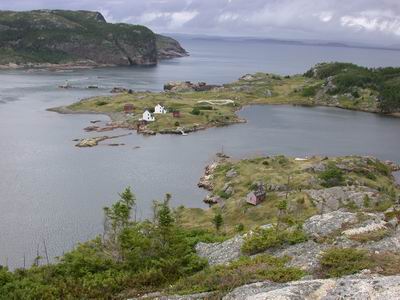
Rationale:
Aquaculture requires a database of
scientific knowledge for improving production.
Academic researchers offer much scientific
experience and expertise, and there is a broad
overlap between academic research and
aquaculture interests. In addition, information on the
production characteristics of aquaculture
species requires a number of years of research.
Therefore, improvements to aquaculture
production require a long-term investment in research.
The mussel hybrid zone in Atlantic Canada
offers an excellent opportunity for basic scientific
research on how mussel ecology, genetics and
hybridization can provide useful information
to improve mussel aquaculture.
Methods:
Diagnostic genetic markers
Mussel species cannot be easily distinguished
based on morphology. Species and hybrids can only
be reliably distinguished using diagnostic
genetic markers. Genetic markers available consist of
enzyme protein variation as well as DNA
variation (nuclear and mtDNA). Genotype can be determined
from a small piece of tissue and each
individual classified as M. edulis, M. trossulus or hybrid.
hybrid M.
edulis M. trossulus
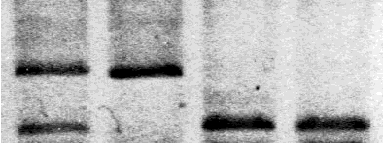
(ITS fragments separated in an agarose gel. Photo: J. Toro)
Shell colour and morphometrics
Once mussel species have been identified
using genetic markers, the species can be examined for
any difference such as shell morphology and
colour. There is a tendency for M. trossulus to have a
darker inner shell compared to M. edulis
at some sites in Newfoundland.
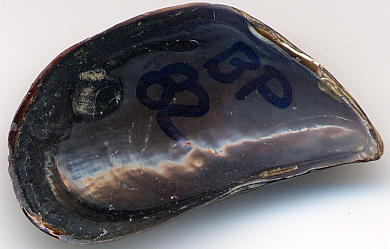
M. trossulus

M. edulis
A canonical variates analysis based on
several shell characteristics shows that
M. edulis and M. trossulus are morphologically distinct. However, the
presence of
hybrids blurs this distinction. (Figure from J. Toro, 1999)
Change in genetic composition with shell length and life history stage
Genetic markers have been used to examine
the change in relative frequency
of the two mussel species and hybrids among
mussels differing in shell length.
M. trossulus individuals dominate the spat and smaller size classes
while M. edulis
is most frequent in the larger size-class
mussels. Hybrids occur with low frequency
for all size classes. This pattern suggests
that M. trossulus has a greater mortality
and slower growth rate compared to M. edulis.
M. edulis can therefore grow to
a larger size. (Figure from Toro, Innes and Thompson, in review)
Larvae
Samples of larvae just prior to settlement
showed a high frequency of M. trossulus
and a lower frequency of M. edulis and
hybrids with mixed genotypes based on two
genetic markers. First generation hybrids (F1)
occurred with the lowest frequency. These
observations suggest that factors controlling
the production of hybrids occur earlier in
the life history than the pre-settlement larval
stage.
Variation in the reproductive cycle
Measurements of the reproductive cycle (Gamete
Volume Fraction) show that M. trossulus has a
greater investment in gametes than either M.
edulis or hybrids. The results also show that M. edulis
spawns (drop in GVF between June and July) more
completely than M. trossulus and hybrids.
This temporal difference in spawning may reduce
the probability of hybrids being produced.
Other experiements show that gamete
incompatibility and mortality during the early embryo
stage also play a role in reducing the probably
of hybridization (Miranda, in prep.).
(Figure from Toro, Thompson
and Innes, 2002)
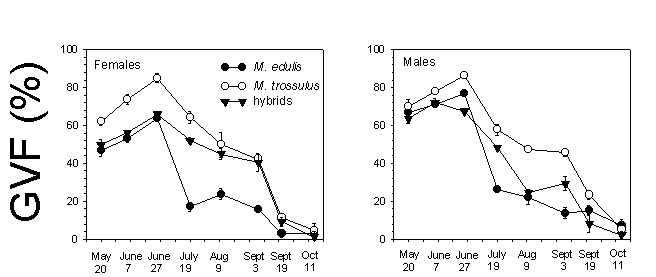
Growth at Aquaculture sites
Groups of mussels of known species
composition have been produced in the
laboratory by pooling families of M. edulis,
M. trossulus and hybrids. Two types
of hybrids were produced with either M.
edulis (Hybrid Ed) or M. trossulus
(Hybrid Tross) acting as the female parent.
These mussel have been growing
at two different aquaculture sites. The results
to date show that M. edulis had
the greatest shell growth with M. trossulus
and Hybrid Tross showing the
smallest shell growth. (data from M. Miranda and B. Lowen)
M.
trossulus
M. edulis
Condition Index
M. trossulus showed a significantly greater condition index than M.
edulis. This is
consistent with M. trossulus having a
greater investment in reproduction than
M. edulis. (Data from B.
Lowen)
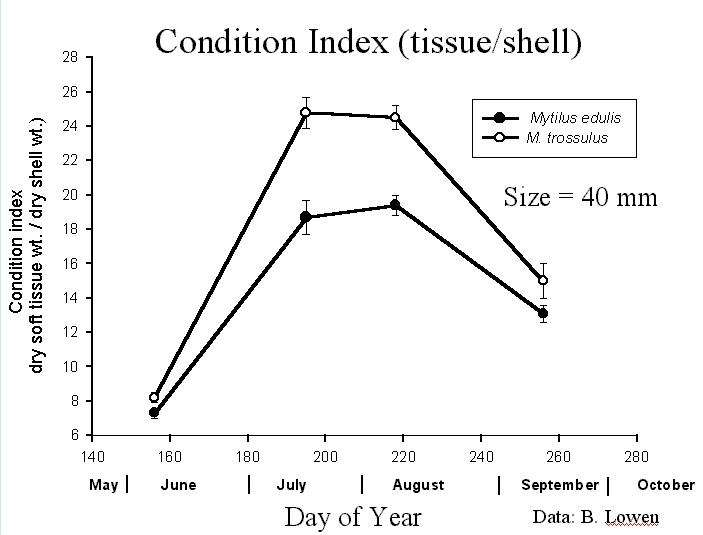
Mortality
Hybrids showed the greatest mortality. (Data from B. Lowen)
Summary:
The careful control of species composition using genetic markers has allowed
experiments
to document life history differences between
the coexisting mussel species M. edulis, M. trossulus and
their hybrids. These life history differences
likely play an important role in maintaining the coexisitence
between the two species. Furthermore, both pre-
and postzygotic isolating mechanisms prevent
extensive hybridization between the species.
Further research is in progress to determine genetic
and ecological factors that maintain this
mussel hybrid zone. These studies can also provide information
on performance characteristics that can assist
in increasing mussel production at aquaculture sites
by favouring one species or the other.
Mussels also show a great deal of variation
in shell colour and shape, some of which is under genetic control.
Shell colour in mussels has a simple genetic
basis:

Contact for further information: David Innes (dinnes@mun.ca)
Papers:
Toro, J. E., D. J. Innes and R.
J. Thompson (2004) Genetic variation among life-history stages of mussels in a
Mytilus edulis –M. trossulus hybrid zone. Marine Biology 145, 713 – 725 (download PDF file)
Toro, J. E., R. J. Thompson and
D. J. Innes (2002) Reproductive isolation between coexisting mussel species
(Mytilus edulis, M. trossulus) in Newfoundland. Marine Biology
141, 897–909.
(download PDF file)
Comesana, A. S., Toro, J. E., Innes, D.
J. & Thompson, R. J. 1999 A molecular approach to the ecology
of a mussel
(Mytilus edulis - M. trossulus) hybrid zone on the east coast of Newfoundland,
Canada. Marine Biology 133, 213-221.
(download
PDF file)
Innes, D. J. & Bates,
J. A. 1999 Morphological variation of Mytilus edulis and Mytilus
trossulus in eastern
Newfoundland. Marine Biology 133, 691-699.
(download
PDF file)
Bates, J. A. & Innes,
D. J. 1995 Genetic variation among populations of Mytilus spp. in
eastern Newfoundland.
Marine Biology 124, 417-424.